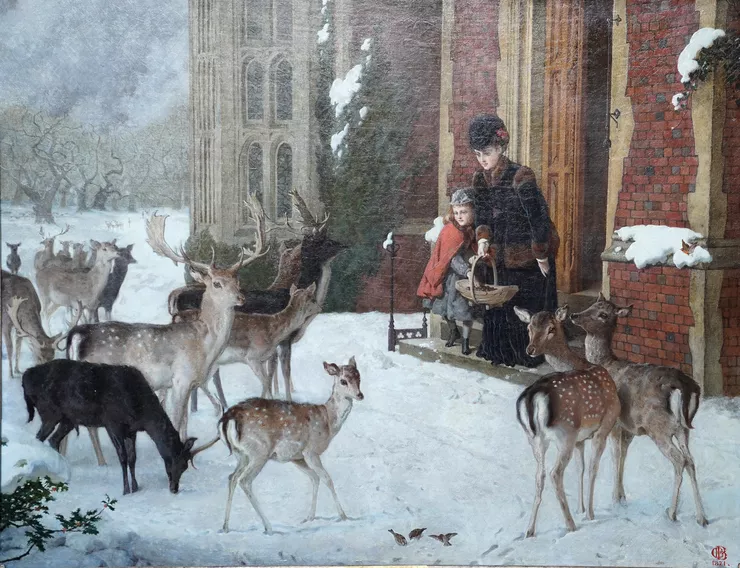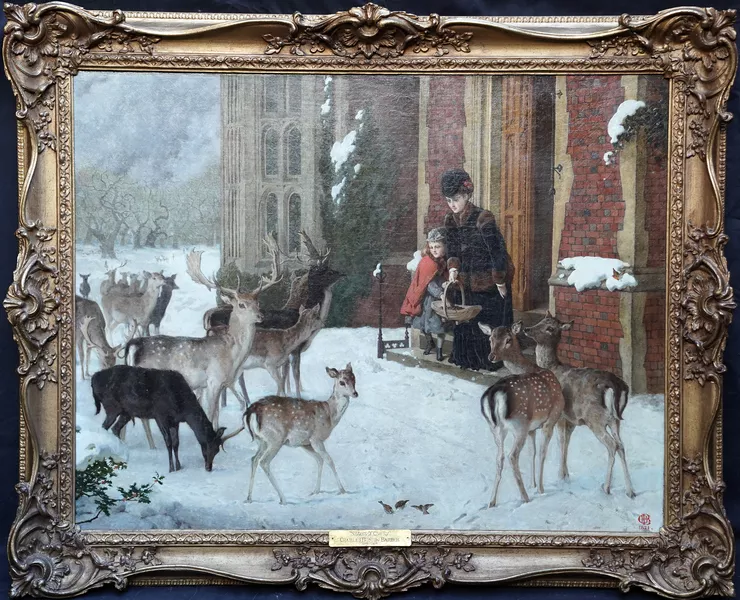Charles Burton Barber (1845-1894)
| Artist Name | Charles Burton Barber (1845-1894) |
|---|---|
| Title | Sisters of Charity |
| Description | This simply wonderful British Victorian exhibited oil painting is by noted and much sought after British children and animal artist Charles Burton Barber. Barber received several commissions from Queen Victoria as her court painter including painting her with her grandchildren and dogs. This lovely work was painted in 1871 and exhibited the same year at the Royal Academy, London and is entitled Sisters of Charity. The composition is of two sisters on the snowy doorstep of a grand Victorian country house, complete with its bell pull and leaded windows. They are wrapped up for the cold and are preparing to feed the deer from a trug of nuts. They are surrounded by a large herd of different types of fallow deer, including those with white spots on their coats and melanistic deer which are almost entirely black or chocolate coloured. In the background one can see more deer in the snow-covered wooded landscape. It is an unapologetically sentimental painting in the best sense of the word and has the interest of being different to Barber's more usual paintings of children and dogs. The detail and brushwork on the deer are just superb. This is a super example of a British Victorian animal oil painting and an excellent example of Barber's work with sound provenance and ideal for Christmas. Signed with monogram and dated 1871 lower right. Name plate and title also on frame. |
| Provenance | Exhibited at the Royal Academy London in 1871 no. 535 entitled Sisters of Charity. Beaton Brown Mayfair London Gallery label verso with painting details. |
| Medium | Oil on Canvas |
| Size | 35 x 28 inches |
| Frame | Housed in ornate swept gilt frame, in good condition, 43 inches by 35 inches approx. |
| Condition | Good condition. |
| Biography | Charles Burton Barber (1845–1894) was a British painter who attained great success with his paintings of children and their pets. Barber was born in Great Yarmouth in Norfolk, and studied from the age of 18 at the Royal Academy, London - receiving a silver medal for drawing in 1864, and first exhibiting there in 1866. During his lifetime Barber was regarded as one of Britain's finest animal painters. He was not only a painter, he was also a skilled carver in, both, wood and metal; he made his own fittings. Barber was a great admirer of the work of Sir Edwin Landseer; it is believed that he was inspired by it as he too loved the outdoors and painting deer. Following the death of Landseer, Barber was chosen as Queen Victoria’s court painter. A quiet, private man, Barber did not use his new position to expand his reputation. The only income he earned from the Queen’s patronage was from the commissions themselves. He received commissions from Queen Victoria to do paintings of her with grandchildren and dogs, and also the Prince of Wales (later Edward VII) and his pets. Whereas Landseer painted mainly the royal family, Barber painted the Queen, her grandchildren, and their pets. Landseer tended to paint his animals with more human expressions, but Barber’s animals retained their animal-like expressions. By keeping his animal subjects with their own features yet still managing to convey sadness, excitement and longing, Barber carved out a niche for himself. In 1876, the Queen commissioned Barber to paint what would be titled ‘Queen Victoria and John Brown’ as a gift to her faithful servant. A number of his portraits are in the Royal Collection. He exhibited at the Royal Academy from 1866 to 1893. In 1883 he was elected a member of the Royal Institute of Oil Painters. Barber became a very popular sporting and animal painter, specialising particularly in sentimental portraits of dogs, often with children. His work ranged from photographically realistic to quick sketches. Although some have regarded his work as overly sentimental, his work remains popular, largely because of his competent painting. Barber received his final commission in 1894 to paint Queen Victoria, with her grandchildren, in her pony-carriage. He died in London soon afterwards. His place as foremost painter of children and pets was taken by Arthur Elsley. Many of Barber's paintings were made into prints, usually in the medium of photogravure. He exhibited at the Royal Institute of Oil Painters, Walker Art Gallery and Manchester Art Gallery. Much of his art is at the Lady Lever Art Gallery in Port Sunlight |
| Price | SOLD |

